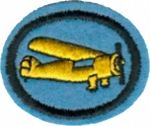Difference between revisions of "AY Honors/Airplane Modeling/Answer Key/es"
From Pathfinder Wiki
< AY Honors | Airplane ModelingAY Honors/Airplane Modeling/Answer Key/es
(Created page with "{{clear}}") |
(Created page with "{{clear}}") |
||
| Line 213: | Line 213: | ||
{{clear}} | {{clear}} | ||
| − | + | {{clear}} | |
; V-Tail: V-Tail aircraft are planes that have only 2 stabilization surfaces (in the shape of a V) instead of a conventional horizontal and vertical stabilizers. In a V-Tail aircraft, the 2 control surfaces of the V-Tail work together to give elevator and rudder responses. | ; V-Tail: V-Tail aircraft are planes that have only 2 stabilization surfaces (in the shape of a V) instead of a conventional horizontal and vertical stabilizers. In a V-Tail aircraft, the 2 control surfaces of the V-Tail work together to give elevator and rudder responses. | ||
Revision as of 21:40, 1 December 2014
| Aeromodelismo | ||
|---|---|---|
| Asociación General
|
Destreza: 1 Año de introducción: 1944 |
|
Requisitos
1. Construir y volar con éxito un avión de un kit de madera de balsa y papel, que sea propulsado por una banda de goma o por gas.
2. Construir un planeador con madera de balsa de un modelo prefabricado y observar sus características de vuelo en relación a la variable posición de las alas.
3. Hacer y volar con éxito 2 diferentes estilos de aviones utilizando hojas de papel de entre 20 centímetros y 35 centímetros de ancho y largo.
4. Definir, ubicar y explicar el uso de los siguientes elementos básicos:
a. Fuselaje
b. Ala
c. Alerón
d. Timón
e. Estabilizador horizontal
f. Soporte del ala
g. Cabina
h. Motor
i. Tren de aterrizaje
j. Propela
- V-Tail
- V-Tail aircraft are planes that have only 2 stabilization surfaces (in the shape of a V) instead of a conventional horizontal and vertical stabilizers. In a V-Tail aircraft, the 2 control surfaces of the V-Tail work together to give elevator and rudder responses.
Categories:
- Categoría: Tiene imagen de insignia
- Adventist Youth Honors Answer Book/Honors/es
- Adventist Youth Honors Answer Book/es
- Adventist Youth Honors Answer Book/Skill Level 1/es
- Categoría: Libro de respuestas de especialidades JA/Especialidades introducidas en 1944
- Adventist Youth Honors Answer Book/General Conference/es
- Adventist Youth Honors Answer Book/Unknown/es
- Adventist Youth Honors Answer Book/Unknown/Primary/es
- Adventist Youth Honors Answer Book/Stage 100/es
- Adventist Youth Honors Answer Book
- Adventist Youth Honors Answer Book/Completed Honors
- Adventist Youth Honors Answer Book/Arts and Crafts

